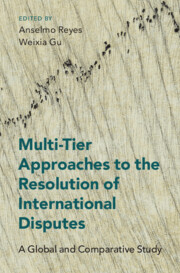Book contents
- Multi-tier Approaches to the Resolution of International Disputes
- Multi-tier Approaches to the Resolution of International Disputes
- Copyright page
- Contents
- Figures
- Tables
- Contributors
- Acknowledgements
- Table of Cases
- Table of STATUTES AND INSTRUMENTS
- Table of Rules, Codes and Guidelines
- Abbreviations
- Part I A Global Overview of Multi-tier Dispute Resolution: Main Themes
- Part II Multi-tier Dispute Resolution in Asia
- Part III Multi-tier Dispute Resolution in the Wider World
- 11 Multi-tier Commercial Dispute Resolution Processes in the United States
- 12 Multi-tiered Dispute Resolution Clauses
- 13 Multi-tier and Mixed-Method Dispute Resolution in Canada
- 14 Multi-tier Dispute Resolution in Australia
- 15 Praised, but Not Practised
- 16 Multi-tier Dispute Resolution in Russia
- 17 Multi-tier Dispute Resolution under OHADA Law
- Part IV Conclusion
- Bibliography
- Index
15 - Praised, but Not Practised
The EU’s Paradoxes of Hybrid Dispute Resolution
from Part III - Multi-tier Dispute Resolution in the Wider World
Published online by Cambridge University Press: 09 December 2021
- Multi-tier Approaches to the Resolution of International Disputes
- Multi-tier Approaches to the Resolution of International Disputes
- Copyright page
- Contents
- Figures
- Tables
- Contributors
- Acknowledgements
- Table of Cases
- Table of STATUTES AND INSTRUMENTS
- Table of Rules, Codes and Guidelines
- Abbreviations
- Part I A Global Overview of Multi-tier Dispute Resolution: Main Themes
- Part II Multi-tier Dispute Resolution in Asia
- Part III Multi-tier Dispute Resolution in the Wider World
- 11 Multi-tier Commercial Dispute Resolution Processes in the United States
- 12 Multi-tiered Dispute Resolution Clauses
- 13 Multi-tier and Mixed-Method Dispute Resolution in Canada
- 14 Multi-tier Dispute Resolution in Australia
- 15 Praised, but Not Practised
- 16 Multi-tier Dispute Resolution in Russia
- 17 Multi-tier Dispute Resolution under OHADA Law
- Part IV Conclusion
- Bibliography
- Index
Summary
Incentivising the use of multi-tier dispute resolution in the EU raises challenges. An underlying statute (the EU Mediation Directive) has been promulgated to encourage greater acceptance of mediation, but field responses have varied. This chapter addresses key issues for the future of mediation and hybrid dispute resolution in the EU. Insofar as hybrid dispute resolution is underdeveloped or not much used in the EU, the chapter identifies reasons for such situation. Most issues with hybrid dispute resolution contracts in the EU stem from the lack of an enforcement regime for such agreements. The chapter thus addresses the question whether, assuming that a greater use of hybrid dispute resolution is a good thing, measures can be taken to increase resort to hybrid dispute resolution in the EU. The chapter also examines concerns expressed over procedural defects in the use of multi-tier modes of dispute resolution and what (if any) safeguards have been put in place by different member states to remedy those defects. Finally, this chapter considers the extent to which (if at all) the EU should become party to the Singapore Convention and whether the Convention would make any difference to the position today in respect of multi-tier dispute resolution. Is the EU likely to join the Singapore Convention? Most issues pertaining to enforcement of multi-tier dispute resolution contracts would be resolved if the EU were to become a Contracting State. That is because the Singapore Convention would provide a harmonised basis for enforcing settlement agreements among EU member states, which is an objective of the EU Mediation Directive. Joining the Singapore Convention will, however, depend upon its compatibility with EU law. Insofar as it is competent to join, there would be clear benefit to the EU in so doing.
- Type
- Chapter
- Information
- Multi-Tier Approaches to the Resolution of International DisputesA Global and Comparative Study, pp. 363 - 383Publisher: Cambridge University PressPrint publication year: 2021

